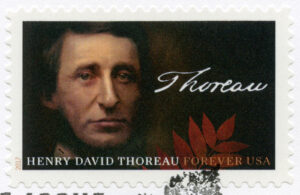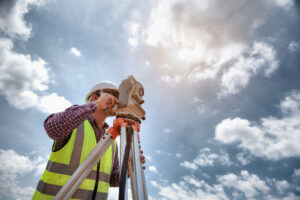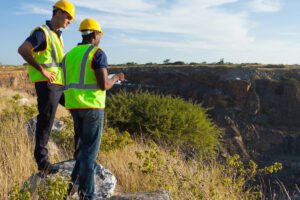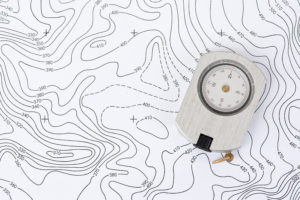Land and Stars: The Zenith Telescope & Other Land Surveying Instruments
30 July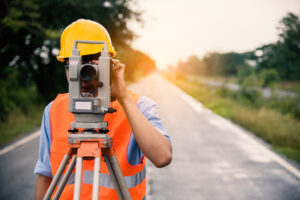 Most people that use GPS technology for long drives and family vacations might not think twice about latitude and longitude. Early explorers and navigators had a very different experience when it came to venturing into unknown lands and oceans. And even though we don’t think about it, GPS depends on geodetic coordinates or latitude and longitude. For generations, people have depended on coordinates to travel and navigate the world. The tools and instruments of navigation are not that different from those used for land surveying.
Most people that use GPS technology for long drives and family vacations might not think twice about latitude and longitude. Early explorers and navigators had a very different experience when it came to venturing into unknown lands and oceans. And even though we don’t think about it, GPS depends on geodetic coordinates or latitude and longitude. For generations, people have depended on coordinates to travel and navigate the world. The tools and instruments of navigation are not that different from those used for land surveying.
So let’s explore some of these amazing tools that have improved the way we understand our world.
The Mystery of Longitude and How it Was Solved
Latitude runs parallel to the equator and is, therefore, easier to determine. It is determined by nature, whereas longitude proved to be a far more difficult problem to solve. Determining how far east or west a ship was from the land was a challenging endeavor and led to some fascinating maritime history. The difficulty in longitude made travel by ocean and sea very perilous and sometimes costly to merchants, explorers, and sailors.
In a well-known story that happened in the Scilly Isles in southern England, massive wreckage led the British government to offer a big cash prize for anybody that could solve the longitude problem. This was known as the famed Longitude Act of 1714. The wreck at Scilly Isles had caused a lot of damage and had been one of many shipwrecks that had destroyed property, goods, and human lives.
The problem of longitude came down to maintaining consistent time at an agreed-upon zero-meridian. Sailors would have to set the ship’s clock at exactly 12 when the sun was directly overhead, but clocks could not withstand the motion and changes of the sea. So sailors knew that an hour meant 15 longitudinal degrees of separation so they could convert the hour into a geographical measurement. And yet, it kept failing, as establishing precise time and keeping time was difficult on the ships.
This problem was solved by one unschooled fella named John Harrison, who invented an oil-free clock and would carry true-time across any turbulent sea. Harrison was recognized for his genius and his clocks were mass-produced, helping ships calculate longitude accurately and arrive safely at their destination. He is central to British maritime history.
The Zenith Telescope and Geographical Measurements
A zenith telescope has an amazing little story and forms an important part of the study of the skies. It is a refracting telescope that is designed to observe the stars overhead. As early as the 1700s, scientists and sky enthusiasts were looking for ways to better understand and measure the earth’s movement. In 1725, the aberration of starlight was discovered using one of these telescopes. It measures differences in zenith angles which helps to determine latitude location.
Zenith telescopes were also made portable, and this meant they could be used for geodetic purposes. A man by John Bird living in London was responsible for the first zenith telescope used in America.
The U.S. Corps of Engineers
During the 19th century, groups like the U.S. Corps of Engineers created a powerhouse of innovation in various areas of construction and land development. The field of surveying grew and so did the surveyor’s toolbox.
Captain Andrew Talcott of the U.S. Corps of Engineers continued to develop the methods of using zenith scopes to determine latitude. While working on the state boundary between Michigan and Ohio, he used a slightly different method. Earlier surveyors had paid attention to only the stars that passed about one degree or less of the zenith. Talcott focused on pairs of stars that moved through in equal distances. The method of measuring the zenith distance and finding the latitude is called the Talcott method.
The zenith telescope was used to demarcate state borders as newer states were being formed and new boundaries were decided upon.
The Surveyor’s Compass
A surveyor’s compass is unique from other compasses because it has vertical sights for aiming at distant objects. The surveyor’s compass came along in places with vast land exploration and was first referenced in Art of Surveying (London, 1610). These are vernier compasses with a variation arc and vernier mechanism. An Improved Surveyor’s Compass could measure horizontal angles without referencing magnetic north. This newly patented version of the compass helped many early railroad engineers improve their building process.
Get Accurate Land Surveys With Experienced Surveyors in El Paso
Whether it’s for a new home, a commercial property, a larger structure, or a building, a land survey is a must. Accuracy is our motto. Customer service is always our driving force. Land-Mark land surveyors are here to serve the community of El Paso and beyond. How can we help?
Land-Mark Professional Surveying provides the southwest with land surveying services. Connect with us today and find out more.
How Land Surveying Influenced One of America’s Favorite Poet & Essayists
28 MayMany prominent people have gotten their start or dabbled in the art of land surveying. As we’ve covered in previous posts, well-known American figures have connected with the land through the art of land surveying. The work is ideal for those who see the beauty of the natural world. During the mid 19th century, America produced many memorable poets and writers that were essential in articulating and refining the American ethos and the philosophies of the New World. One name that is synonymous with harmonious living in the natural world — particularly as technology and cities began to grow— was Henry David Thoreau, known as an American environmental writer and essayist. When he wasn’t philosophizing and thinking profoundly about man’s relationship to nature, Thoreau was working as a land surveyor.
The Mark of Land Surveying on the Life of a Profound Thinker
Classical education in American history will likely come across the likes of Massachusetts native Henry David Thoreau and his work. With such well-composed life advice and profound thinking, Thoreau was known for his thoughts on capitalism, nature, and the individual. The son of a pencil factory owner, Thoreau became an apprentice to Ralph Walde Emerson—another big name in American literature. This meant that young Thoreau would be heavily steeped in the Transcendental tradition of his mentor. For the Transcendentalist, the way to a meaningful life was in the ability to hold oneself or maintain one’s separation from the material world and material wealth. This was an American delineation of the British Romantics, who saw the natural world as the arbiter towards spiritual transcendence and peace. Emerson wrote, “Mind is the only reality, of which all other natures are better or worse reflectors. Nature, literature, history, are only subjective phenomena.” This type of transcendentalist thinking was to inform much of Thoreau’s work, although he would depart from heavily discounting the power of nature on individual development. On the contrary, Thoreau put a lot more significance on nature and its presence in our lives.
Perhaps a little less known fact about the famous writer was that he was also a strong-minded abolitionist who participated in the Underground Railroad and railed heavily against slavery. During this time as a conductor at the Underground Railroad, he helped several slaves escape to Canada.
A Young Land Surveyor Uses Surveying to Inform His Work
As Thoreau worked parceling land that would be sold off to loggers. He used land surveying as his day job and dedicated himself to writing on his time off. He became Concord’s head surveyor in 1851. A close look at land surveying of the 19th century reveals that there were no licensing requirements to do the work. So land surveyors relied heavily on recommendations and their past work to vouch for them. Thorough was a man known in the surveying community as a man of integrity and this fared well for his ability to continue getting work.
The US Coast Survey formed in 1807 was important for the young land surveyor. The survey was conducted under the public spotlight and brought questions to the forefront about the role of science in democracy. These early surveys often had a significant impact on the shaping of society and people’s understanding of private property in the early days of the nation.
Land Surveying in the Mid 19th Century
The century has many important people working as land surveyors, but the work itself — done across the country — would help shape so much of America today. One of the most famous texts was the 18th-century treatise called “The Complete Surveyor or the Whole Art of Surveying Land.” This book was influential for other early surveyors including George Washington and Henry David Thoreau. The process of land surveying looked a little like this:
- The selling or distribution of the land to a prospective owner
- A prospective landowner would obtain a warrant
- A surveyor would go out to the location with the prospective owner
- They would mark out and demarcate the property line
- The surveyor would prepare a plat or special map of the boundaries
- The surveyor would include a textual description
- This document would serve as the deed to the land
The Long Tradition of Land Surveying in America
These figures have included the first president of the United States, George Washington, and founding father Thomas Jefferson. We have also covered the Lewis and Clarke expedition that gave way to a better understanding of the American Western frontier. The Lewis and Clarke expedition helped the American expansion efforts. In Europe at this time, land surveying would use a lot of transits, theodolites, and star charts, early surveying in the colonies used a different method that involved a long Gunter’s Chain to measure and demarcate the property. Most of the land surveyed east of the Ohio River was done using this method.
Land Surveying You Can Trust in the El Paso Area
Here at Land-Mark, we continue the great tradition of land surveying. The great predecessors of the industry have left behind great lessons of land surveying and much of their history.
As one of the Southwest’s most dependable land surveying firms, we are ready to help you survey your land with accuracy and reliability. Call us today and find out more about what we do.
The Evolution of the Land Surveyor’s Tool Kit: From the Romans to the 21st Century
26 MarchLand surveys today benefit from hundreds of years of experience, knowledge, and tools. Our map creation of today uses anything from magnetic locators to special telescopes, to drones and satellites. The men tasked with early land surveys had simple equipment and employed special and innovative techniques to get the job done. As we saw in our series about Lewis & Clark, some of America’s most notable land surveyors, these early pioneers didn’t have much to work with but their knowledge of the land propelled them forward. Land surveys rely on smart techniques but also on their tools to get the job done.
Early Tools and Techniques for Surveying and Understanding the Land
Even ancient peoples had the urge and necessity to understand the land that surrounded them. It is an essential part of civilization—though not often discussed as such.
The Roman Groma
One early instrument in the history of land surveyors seems to have made its way from Mesopotamia. The Groma looks rather simple. It is a vertical staff with horizontal staff pieces at right angles. It was also adopted by the early Romans to measure land in the empire for taxation purposes.
The Greek Diopter
With the advancement of math and geometry came advancements in other fields. Land surveying advanced as the art of measurements and mathematical equations developed further. The Greeks developed the diopter. This was a lightweight portable tool composed of a cogwheel. They used water levels and astronomical features to survey a property. The theodolite—an instrument still used today— seems to have derived or at least been inspired by the early Greek diopter.
Land Surveying in Early Europe and American History
As Western civilizations expanded, the need to understand and record features of the land became more and more important. As the British Empire extended its borders across great lands, the explorers that led these expeditions sought to understand the lands in which they ventured.
In 1571, Joshua Habermel created the first theodolite. Modern versions of this tool still exist today and form part of the day-to-day surveyors kit. This is a precise instrument that requires a tripod and compass. When early Europeans began using the technique of triangulation, it improved the accuracy of the measurements of boundary lines. This early European method of triangulation was used up to the 1980s because of its simplicity and accuracy.
The Use of Celestial Maps & the Night Sky
In the mid 18th century, the theodolite was improved by the addition of a scope. Today’s Theodolite, for example, is a rather sophisticated telescope derived from these early versions. Surveyors around this time used sextants, which measured angles using celestial maps.
The Use of Other Early Tools
The land surveyor’s tool kit has evolved but the ideas have remained the same. Below is a list of various other early tools used by pioneer land surveyors that learned to be creative and innovative with what was at hand.
- Gunther’s Chain: This tool was around during the 17th century. It is a thin-looking chain consisting of a linked chain that is pinned to the ground and extended outward up to 60-65 feet. It helped surveyors define a path and record measurements from endpoint to endpoint.
- Gunter Surveyor Compass: Angles are critical for land surveys. Many of the tools that were developed early on focused on using angles to measure distances and terrain. Also known as the circumferentor, this tool helped determine right angles.
- Zenith Telescope: This is a refracting telescope and was pretty sophisticated for its time. It was designed to observe the night skies and contributed to the understanding of Earth’s rotation and axis. Portable versions of this telescope were used for land surveys including latitude determinations.
- Ramsden Theodolite: Jesse Ramdsen developed the Ramsden Theodolite in the late 1700s. He was an innovative London instrument maker that was tasked with creating an accurate instrument that used triangulation to divide England. The instrument weighed up to 200 pounds.
The Day-to-Day Instruments Used for Land Surveying Today
Most days it depends on the job. When surveying relatively flat terrain in the middle of a city to surveying mountain regions or deserts, there are various instruments and equipment that can be used. On any given day you might find your local land surveyor using the following:
- Surveying magnetic locators
- Surveyors safety vests
- Surveying tripods
- Marking paint
- Automatic levels
- Total stations
- Theodolites
- Electronic levels
The list goes on. Depending on the kind of job and the kind of survey that needs to be done, the tool kit may vary slightly.
Get Accuracy and Reliability with Land-Mark Land Surveyors
As experts in the industry, we have seen the development of many new technologies and equipment over the years. It is no substitute for knowing how to do the job. We pride ourselves on efficient and accurate work here at Land-Mark. From residential surveys to government contracts, we get the job done.
Need a reliable land survey? Trust the experts in El Paso and the Southwest. Call Land-Mark today.
America’s Most Famous Land Surveyors: The Journey of Lewis and Clark (Part II)
29 JanuarySurveying and map-making began as a treacherous and rather dangerous enterprise. It wasn’t for the faint of heart. Lewis and Clark were one of history’s most important land surveyors. They and their crew would be responsible for changing the course and expansion of America. In our last post, we explored the background of Lewis and Clark and some of the surveying tools that they would take on their journey. Today we continue our remembrance of this historic expedition and the surveying marvels that were born from this trek across unknown lands.
Two Surveyors, a Guide, & Thousands of Miles
In addition to their early surveyor tools like compasses, quadrants, telescopes, and chronometers, Lewis and Clark also gathered other necessary equipment. Some of these included weapons and ammunition, medical supplies and medicines, books on botany, geography, and astronomy, maps, as well as gifts to present to Native Americans they knew they’d run into including beads, face paint, ivory combs, and more.
The duo recruited 45 brave souls to join them on their way westward. Among these were 27 unmarried men, a French-Indian interpreter, a boat crew, and Clark’s slave known as York. One other unique characteristic about the Corps was the fact that it was a rather eclectic and diverse bunch. In addition to the Southern roots of Lewis and Clark, there was his slave, a one-eyed-part-French-part-Omaha-Indian fiddler player, a German named John Potts, and the famous Sacagawea, a Shoshone Indian.
Both Lewis and Clark knew the journey would require incredible tenacity and discipline and so they ran a tight ship.’ Historical accounts describe how the corps was led with an iron fist, including harsh punishments like bareback lashing and hard labor for dissidents or uncooperative members of the team. It is the ultimate adventure story, only one person of the crew would die during the journey—a 22-year-old who died of an abdominal infection.
The team headed northwest along the Missouri River. Thomas Jefferson tasked them with several missions and goals for the expedition. These included finding and mapping a route across the continent, making detailed observations and notes regarding the natural geography, landscapes, and natural resources out West. At the same time, the team was meant to establish good relationships with native peoples along the way to interrupt the British dominance of the fur trade in the areas.
By mid-October, the expedition had reached the Mandan villages on the Missouri River. This important trading place allowed them to make some connections and talk to others about possible routes westward. The team had moved to South Dakota, North Dakota, and Montana. From the Mandan Villages, the crew was now facing the Rocky Mountains, the highest mountain range. One famous story was of Merriweather Lewis falling 20 feet into a cavern, was poisoned, and then shot in the thigh.
The now-famous Sacajawea, the wife of one of the Frenchmen in the expedition, proved to be invaluable for the success of the journey, as her language skills and knowledge of the territory proved essential. By the winter of 1805, they had reached the Columbia River and made a transcontinental crossing north of Mexico.
By the end, the expedition has traveled about 8,000 miles while pushing, pulling, and hauling ‘the boat’, the famous keelboat of the Corps, facing harsh storms, weather, hunger, thirst, and one or two run-ins with bears, friendly and not-so-friendly Indians, exhaustion, sleeplessness, mosquitoes, venereal disease, dysentery, boils, ticks, injuries, and God knows what else. The crew also found themselves face-to-face with some elk, buffalo, and deer, which they kindly turned into campfire dinners.
Throughout the trek, many of the men kept detailed journals, which would serve them well, as many of the maps and drawings they tried to send back to Jefferson during their journey never made it through. Finally, the crew made it to the West Coast, moving through northern Montana, Oregon, and present-day Washington onto Ft. Clatsop.
The Land Surveyors Return Home to a Hero’s Welcome
When Merriweather Lewis and William Clark returned to St. Louis with their crew, they were celebrated as pioneers and heroes of the time. The crew arrived back in St. Louis in September. The Corps of Discovery go their own way, but Lewis is named governor of the Louisiana Territory, while Clark becomes an Indian agent for the West. Most of the intended goals of the journey were met. This included establishing diplomatic relationships with Native Americans. The crew held councils with Indians and participated in events with them. Upon his return, Lewis had identified 178 plants including bitterroot, prairie sagebrush, Douglas fir, and ponderosa pine. They had also identified 122 animals such as grizzly bears, prairie dogs, and pronghorn antelope.
A Tradition of Land Surveying Continues With Unprecedented Precision
Lewis and Clark’s journey is seen differently among historians. For many, the journey was one of the first tales of American exceptionalism and would spearhead a movement of westward expansion and discovery. Others focus on the tragedies that plagued the journey. In the end, the expedition’s contributions to early maps of American territory are indisputable. The flourishing country understood its terrain and natural resources much more in-depth than it did before 1804.
As land surveyors, we can only admire the skill and technical understanding of Lewis and Clark in their creation of maps. Their understanding of geography, astronomy, and climate, allowed them to make extraordinary conclusions that turned out to be quite accurate.
While the process is much different today, here at Land-Mark Land Surveying, we move forward with creating detailed and accurate land surveys for construction, government contracts, and more. Connect with us to find out more!
The Amazing Story of Lewis & Clark: America’s Most Famous Land Surveyors (Part I)
24 NovemberYou are given a hand compass and told to go off into this unknown territory and come back with a map and detailed drawings of the land. No GPS. No smartphone. No calls to mom. No helicopter to rescue you. It would be quite the feat! Many people today are used to the convenience and accuracy of GPS for navigation. If you drive into a new city, you likely use navigation tools to find the nearest burger place, hotel, or shopping center.
It wasn’t always like that. In fact, going into the unknown was part of this country’s early history. Somebody had to do it. That person (among others, of course) was Meriwether Lewis and William Clark when they set off West to map the unknown lands beyond the Mississippi River. This incredible history shows just how vast and expansive the United States was and is an inspiring real story of the American spirit on a tumultuous journey.
In past posts, we’ve explored the incredible technology that is changing and enhancing the work of land surveyors across the world. From drones to GPS to smart technology, mapping our world has improved through the implementation of these tools. We thought we’d go back in time to a story that had none of those technologies and surveyed over 8,000 miles with not much more than a pen, paper, and a whole lot of grit.
It Begins With the Son of a Surveyor and a Notable Name in American History
For most people, Thomas Jefferson is the name behind the Declaration of Independence and the third president of the United States of America. He is known as one of the most notable founding fathers who wrote and spoke eloquently about the role of government, led the revolutionary cause, and worked for the republic moving forward. A little unknown fact about Jefferson is that he was a son of a land surveyor and a land surveyor himself. He was exposed to the world of mapping and charting as a young boy and for a time considered pursuing this as his profession. Because of his exposure to the line of work, Jefferson understood the importance and necessity of having accurate maps and surveys of one’s country. He knew that a new nation attempting to build itself could not do without the knowledge of its own lands.
As president, Jefferson emphasized the importance of the landowner and the central role they played in building the country. All of this fueled his ambitions for discovery and exploration, as well as an understanding of what lay beyond the recent territories the country had just acquired.
The Louisiana Purchase obtained after a negotiation had added 827,000 square miles to the United States. This was a lot of unexplored territories. Jefferson was already calling for it to be surveyed. He appointed his secretary, Meriwether Lewis, a known surveyor as well, to lead the expedition. Lewis would choose his friend William Clark and together they would put together a team that would change American history and set an example for pioneers everywhere.
The Two Men That Would Spearhead the Corps of Discovery
Like many early pioneers, William Clark and Meriwether Lewis were men of their era: smart, with a drive for adventure, and a relentless spirit. Lewis went to college in his home state of Virginia and graduated in 1793, no small feat at the time. He joined the Virginia state militia and took part in putting a stop to the Whiskey Rebellion. He would go on to become captain of the U.S Army, and at the ripe age of 27, he became a personal secretary to the President of the United States, Thomas Jefferson.
William Clark joined the state militia of Kentucky when he was nineteen and would go on to serve in the regular Army. He served with his future partner Lewis and would be commanded by George Washington himself as a lieutenant of infantry.
Survey Instruments Used For the Treacherous Expedition
It might be interesting to note that Thomas Jefferson taught Lewis the basic principles of determining latitude by observing altitudes of the sun or a star with an octant. Both Lewis and Clark understood that this was not a journey to take lightly. Both prepared adequately for the journey Jefferson also sent him for formal education and once appointed to head the expedition, Lewis began studying medicine, botany, astronomy, and zoology. He would study and analyze existing maps and journals. Some of the surveying tools they had at the time included:
- Compass
- Quadrants
- Telescopes
- Sextants
- Chronometer
- Tape measure
- Thermometers
- Plotting instruments
Soon, this dynamic duo would set out for the unexplored wildlands of the West. In Part II, we’ll explore their journey, what they ran into, and what they found after miles and miles of exploration, map-making, surveying, and endless adventure.
Here at Land-Mark professional surveying, we have slightly more sophisticated equipment than Lewis and Clark, but we see every job as an adventure. For a professional land survey, contact Land-Mark today.
Land Surveying in the Age of Coronavirus and New Technologies
29 July Much of the world hit the pause button in the middle of March up to May and even continuing on into the summer of 2020. It has been a strange year for everyone worldwide but despite the many changes and shifts, land surveyors have continued to do their jobs in mapping out our world. As it turns out, surveying land is a pretty essential endeavor and one that we may not realize impacts our lives pretty significantly. The last few decades have had a considerable effect on land surveying, as technologies have improved and embedded themselves in the process. We thought we’d take a look at some of the changes in the industry in the past couple of years and how we have coped with the changes of the virus.
Much of the world hit the pause button in the middle of March up to May and even continuing on into the summer of 2020. It has been a strange year for everyone worldwide but despite the many changes and shifts, land surveyors have continued to do their jobs in mapping out our world. As it turns out, surveying land is a pretty essential endeavor and one that we may not realize impacts our lives pretty significantly. The last few decades have had a considerable effect on land surveying, as technologies have improved and embedded themselves in the process. We thought we’d take a look at some of the changes in the industry in the past couple of years and how we have coped with the changes of the virus.
The Close Call — Keeping Land Surveyors Working Through the Pandemic
Across the country, governors made moves to protect their populations by shutting down what they considered ‘non-essential’ businesses. This led to a lot of other businesses to question the metric of ‘essential.’ Who, after all, decides what is essential and what is not in American life. Surveyors across the country began to make a case for their services as quite essential.
President Trump issued two national emergency declarations under the Stafford Act and the National Emergencies Act. Several players petitioned to keep surveying operations open and exempt from the governor’s orders. The letter making this case was shared with other parties including the National Society of Professional Surveyors, which encouraged surveyors all across the country to send to their governors preemptively to prevent shutdowns of surveying operations. While some governors exempted surveyors by name, others did not consider our work particularly necessary. Many appealed this by showing how surveyors are actually critical to the economic well-being of the state. The reason being that many government construction or private construction, building permits, or other infrastructure cannot proceed without a survey.
According to many surveyors across the country, some private-sector jobs have been put on hold by the pandemic but many public sector jobs have increased. This might be because localities and other entities are taking advantage of the reduced traffic and crowds to work on important city projects.
At the same time, land surveyors are not exactly working amidst large crowds. Our profession is pretty isolated and doesn’t require large teams or working in highly trafficked areas. All of our work can easily be done with social distancing and by taking precautions. Here at Land-Mark, we continue to do our important work while ensuring that all of our workers and any member of the public we might come across, is protected.
Another aspect of our industry that has changed considerably has been the use of new technologies. These, of course, have been in the works for many years at this point. We’ve written about how GPS technology specifically has altered our industry, but technology has impacted us in several ways:
Accuracy: Modern instruments allow land surveyors to have an accuracy of measurements. Compared to the tools in use even a decade ago, the accuracy has improved exponentially.
Speed: Today, the speed of the surveying process has also greatly been improved by technology. Accurate results can be presented in a few hours, allowing for projects and infrastructure to get rolling. With the use of drones, for example, areas can be surveyed without exceeding human effort.
Improved possibilities: Development really begins with the land surveys and thanks to the improvement of technology, we are able to create surveys that create even more building possibilities. A lot of cities that are approaching development in a smarter, high-tech way, is a result of improved results in the land surveying arena.
As cities grow, there might be limited space available and large metropolitan areas have to get creative about the way they develop some of these areas. Cities often have to perform complex planning in small and complicated areas. Land surveying is imperative when looking to make the most out of space.
As we look to the uncertain future, we know that land surveying will continue to improve as technology improves. Automation and artificial intelligence will surely trickle into the industry, as they have already begun to do so. The use of drones, for example, has become useful in surveying difficult terrain. Other features like cloud-based storage and instant data seem to be right on the horizon.
Get Accurate Land Surveys for Your Project
Whether you are involved in a private contract, government contract, or public sector infrastructure project, Land-Mark Land Surveying is here to provide the quality land survey you need. Get the right view of the land and proceed with confidence.
Understanding Property Lines: Land Surveys and Maps When Buying Property
28 May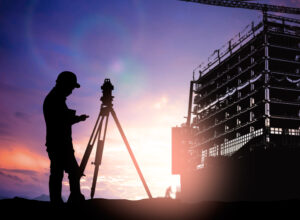 Whether you are a large company purchasing acres of your next commercial infrastructure, or your a government agency looking to build some kind of installation, or you’re a property investor, or even a prospective homebuyer looking to buy acreage on which to put your home, a land survey is more than likely relevant to you.
Whether you are a large company purchasing acres of your next commercial infrastructure, or your a government agency looking to build some kind of installation, or you’re a property investor, or even a prospective homebuyer looking to buy acreage on which to put your home, a land survey is more than likely relevant to you.
Chances are that, at some point in your life, you have seen land surveyors at work on the side of the road on your everyday commute or drive across town. It looks like they’re taking photographs, as they are looking through a telescopic-looking device sitting on a tripod. And yes, it looks like they’re out there taking panoramic photos or admiring the horizon but really they are hard at work taking specific measurements and mappings of the land. The expertise of a land surveyor is in their ability to determine land measurements, topographic heights, and more.
The Right of Way Surveys
One of the main services of many land surveyors, such as Land-Mark, include what are known as Right of Ways Surveys. This refers to the legal right, established by usage or grant, to pass through specific grounds that form part of someone else’s property. In other words, it is the right of passage to another person’s land or property. The term is a common way that land surveyors and other civil engineers use to describe the ability to access another’s property, as it pertains to land usage rights. Examples of a Right of Way might include utilities— gas, electricity, water, telephone, or drainage— to pass through neighboring land, or if your neighbor must access your land in order to get to their property.
There are a couple of options with this:
Property Right of Way: This type of Right of Way (ROW) allows individual access to a person that needs it in order to reach it another location. This might be common on properties that are adjacent to another property that has the only access to the property in question. This may be in absence of a public walkway, lake, or river.
Public Right of Way: A public ROW allows members of the public to access a right of way that is on private land.
Pipeline Right of Way: This type of ROW applies directly to utilities or services that must access private property. This is when the utility company needs to use this private piece of land in order to provide its services and are vital to its operations.
A land surveyor can help you determine the specific details of the ROW by taking measurements of the property and assessing where the property line begins and ends. It is important that if you are the property owner, that you are aware of any ROW that might pertain to your land.
Before you renovate or develop on your land…
This information is key to the development and maintenance of your piece of property. If you are planning on developing your land or building on it, knowing the specifics is essential to ensure a successful project. You don’t want to find out that you have a ROW after you have built over it or disrupted it in some way. By law, it is necessary that you are aware of these types of details on your property.
A ROW can also refer to land owned by a municipality or company that transports goods and/or people. In a way our streets and highways are located on right of ways and so access to any adjacent properties are always to be provided.
Why is a Land Survey Important for Renovations and Development of Property
Knowing precisely the dimension and topography of any site is essential in order to ensure full compliance and abidance of building guidelines, town plans, etc. Even if you think your renovation project is just a room addition or something simple, knowing the precise measurements and boundaries of your property is necessary.
If you are looking to build on your land, a planning permit and/or building permit may be required. A land survey will be a mandatory part of these planning permits.
Get Necessary Land Surveying with Land-Mark
So if you are a property owner that is looking to develop on their land, understanding the historical data that you must take into account will ensure a successful build, project, or expansion. Owning a ROW is important too, as it informs you of necessary access you must provide to others through your property. Call Land-Mark today to get quality land surveying that is not only done quickly but effectively.
Land Surveyors: The Enigmatic Nature of Mapping Out Our World
21 November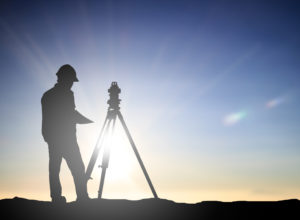 Land surveyors keep an ancient tradition alive. It’s true, land surveying extends far beyond the physical infrastructure. Everyone knows that the world is ‘connected’ today. When we use this phrase we usually refer to digital connections or avenues of communication across borders and oceans via social media sites or websites or access to the same or similar information. And while all that is true—that the world is figuratively more connected than ever—it is also true that there is physical work that is done in order to make these ‘connections’ possible. At the same time, the construction work we see on our way to work, the roadblocks that have us follow detours, all begin with an understanding of the land that is being built on, manipulated, changed. The work before the work is, in some ways, what makes land surveyors enigmatic and somewhat mysterious.
Land surveyors keep an ancient tradition alive. It’s true, land surveying extends far beyond the physical infrastructure. Everyone knows that the world is ‘connected’ today. When we use this phrase we usually refer to digital connections or avenues of communication across borders and oceans via social media sites or websites or access to the same or similar information. And while all that is true—that the world is figuratively more connected than ever—it is also true that there is physical work that is done in order to make these ‘connections’ possible. At the same time, the construction work we see on our way to work, the roadblocks that have us follow detours, all begin with an understanding of the land that is being built on, manipulated, changed. The work before the work is, in some ways, what makes land surveyors enigmatic and somewhat mysterious.
The Building Blocks—Geometry and Ancient Civilizations
Let’s take a step back in time. The concept of surveying or inspecting the land goes way back into civilizations. The division, understanding, and assessment of land serves many purposes and was used as far back as the ancient Egyptians for the purpose of taxation. Early surveys, used different types of instruments to gauge the dimensions of plots of land. According to Purdue University, in 120 B.C the Greeks developed geometry, although there were early versions of it in Egypt. Interestingly enough, the word Geometry means to ‘measure the earth’ and is the science of shape and size of things. Naturally, the science was then used to divide the land into shapes and plots, especially as civilizations grew, governments were established, and personal property needed to be measured and, yes, of course, taxed.
It was in Greece that the first piece of surveying equipment was developed. This was called the Diopter. This instrument was a mobile tool that used a cogwheel and water level to measure terrestrial and astronomical figures on a property. With this tool, the Greeks also developed a standardized method for surveying and basically created a protocol that set the stage for the process for many years.
And on to Europe and then the Industrial Revolution
You might remember a word or two about William the Conqueror from early history classes. Also affectionately known as William the Bastard, as his illegitimate birth was certainly a topic of conversation among royalty circles during his reign (his father impregnated a mistress), he ruled England from the time he was eight years old. Interestingly enough, William the Bastard’s reign was plagued with violence and turmoil, but he managed to maintain control and—despite not knowing English and being illiterate— made great contributions to the development of the English language in early England. He also made a great contribution to land surveying when he ordered a “Domesday Book,” a record of people who owned land in England and the sizes and shapes of their plots. This book placed a great emphasis on demarcating privately owned land and property.
The demarcation of personal property today—and if you are a property owner, then you are highly aware of this— is key in maintaining order and proper city records and plots. In 1571, the first theodolite was created. This was a more precise instrument, as compared with the diopter that came before it. The setup uses a tripod with a compass and is able to create boundary lines. It wasn’t until the 18th century, however, that plots of land began being measured with precise maps of where each was located.
In the 1800s, land surveying became an actual profession. And as the surveying tools improved, the process became more and more important. This was largely due to the rapid increase in population and the growth of cities, roads, and railways. Suddenly surveying land and understanding the landscape on which we built was much more of a necessity.
Land Surveyors in 21st Century Texas
You ask most people what the role of land surveyors is and they might come up with a relatively good educated guess. Most folks, however, know little about the process or understand that it is present before anything can get built. It’s why the surveyor is a kind of ghostly and enigmatic figure that comes in before the groundbreaking begins and plots out the land and territory.
Still in the 20th and 21st centuries, land surveying uses the same basic principles and concepts that were started centuries ago. The development of certain technologies, such as GPS, laser cameras, precision instruments, GIS software, and terrestrial scanning makes everything that much more accurate and efficient.
Surveying the Seas: Internet Cables that Run Our Online World
Another way that these surveying concepts are at work is through the network of cables that connect us all. As the internet has expanded, so has the infrastructure that supports it—even though it’s not often visible. It’s just another arena where the concepts and tools of land surveyors come into play. Fiber optic cable is laid out across the ocean floor to help connect people online. This is often referred to as the secret network that connects the world. It used to be that communications happened through copper cables and electrical signals. Today fiber optic cable that is laid across the land and ocean floor allows for the faster and secure communication we enjoy today. These fiber optic cables are often as thick as a human hair and carry pulses of late that transfer data.
Get An Accurate Land Survey with Land-Mark or Find Out More
At Land-Mark, we take the art of surveying very seriously. We have been in the business for many years and focus on providing accurate readings and maps of the land in question. Whether it is a government contract or a private enterprise looking for their next commercial location, accurate readings of property markings and coordinates are key in protecting yourself down the road from any legal troubles.
Topographic Mapping: Basics and Benefits
23 SeptemberTopographic mapping is at the heart of what we do here at Land-Mark, but often people aren’t sure what it means. It may sound pretty complex, but it’s actually pretty simple and useful. In this article, we’ll briefly discuss what a topographic map is and its uses.
What Is A Topographic Map?
A topographic map is simply a highly detailed map that shows the change in elevation between swaths of land or water. Modern topographic maps use contour lines but have used a number of other methods in the past. They usually cover large areas of land, as smaller maps of this type qualify as chorographic maps—though those are often labeled as topographic anyway.
As can be seen in the picture above, the contour lines on the map are associated with a number that denotes the elevation on that line. The closer the lines are, the more drastic the change in elevation. Topographic maps can be used to show natural and man-made elements.
The Uses of Topography
Topography has a vast array of uses associated with it. Large-scale architecture, for example, needs topography to determine where and how to build. Hiking may also use these maps, as well as mining, civil engineering, and other geographic activities.
Topography With Land-Mark Professional Surveying
Need a topographic map of an area or just have questions about the process? Contact Land-Mark today, and get started on your topographic needs!
A Land Surveyor’s Tool Kit: What We Use in The Field
21 AugustAs land surveyors, we have to carry around a great deal of equipment. We’re often mistaken for photographers because of our tripods, but the rest of our gear quickly dispels that thought. We deal with precise measurements, so it’s crucial to have the right tools on hand. Here we’d like to teach more about our equipment, so you can see us and not mistake us for dedicated Instagram photographers.
- Theodolite – A theodolite is a surveying instrument with a telescope for measuring horizontal and vertical angles. Some land surveying crews use transits and total stations as well, which are used for the same purpose. These can be very pricey; they can range from $200 to over $50,000 in retail price!
- Surveying Tripod – Be sure not to spend all your money on the theodolite, because it needs a place to sit as well. The survey tripod is a sturdy tripod that is designed to move as little as possible for accurate measurements.
- Hand Tools – Besides the main equipment, a surveyor will need a host of other equipment to do the job well. Rope and measuring tape are great for rough measurements and marking, while items like picks and saws help clear debris to properly survey.
- Clipboard – All the data needs to go somewhere, right? A clipboard and pencil are necessary to take measurements or notes down onto paper, or a good PDA would suffice as well.
Land Surveying Done Right
If you’re in need of a land survey, Land-Mark Professional Surveying is the best in the southwest. We work in Texas, New Mexico, and Arizona, and provide quality land surveying for all of our clients. Contact us to see what we can do for you!

